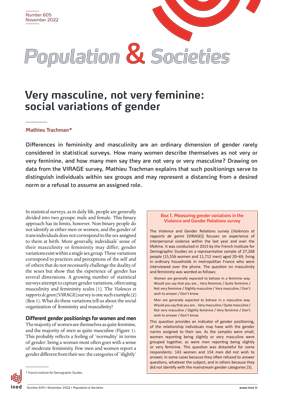Very masculine, not very feminine: social variations of gender
Press release Published on 09 November 2022

Author: Mathieu Trachman
In daily life but also statistical surveys, people are generally divided into two groups: male and female. This binary approach has its limits, however. Individuals’ sense of their masculinity or femininity may differ; gender variations exist within a single sex group. How many women describe themselves as not very or very feminine, and how many men say they are not very or very masculine? Who are these women and men? INED’s VIRAGE survey provides information on these differences in femininity and masculinity, rarely considered in statistical surveys. Drawing on this survey’s data, Mathieu Trachman explains that such positionings serve to distinguish individuals within sex groups.
We learn that the majority of women see themselves as quite feminine, and the majority of men as quite masculine. This probably reflects a feeling of ‘normality’ in terms of gender. Yet, gender positionings are organized differently by the two sexes: while one-third of men report being ‘very masculine’, less than a quarter of women feel ‘very feminine’; just over 9% of women feel ‘not very feminine’, while just 2% of men feel ‘not very masculine’. Differences in gender variations between the sexes doubtless reflect a lower value attributed to what is female than to what is male, but may represent a distancing from a desired norm or a refusal to assume an assigned role.
This article examines not only the way gender norms may be linked to physical appearance and corpulence and sexual identification (whether the respondent self-identifies as heterosexual, bisexual, or homosexual) but also how educational level and occupational category can affect gender positionings. These positionings thus emerge as uncertainties about what it means to be a man or a woman, which serve to distinguish individuals within sex groups.








